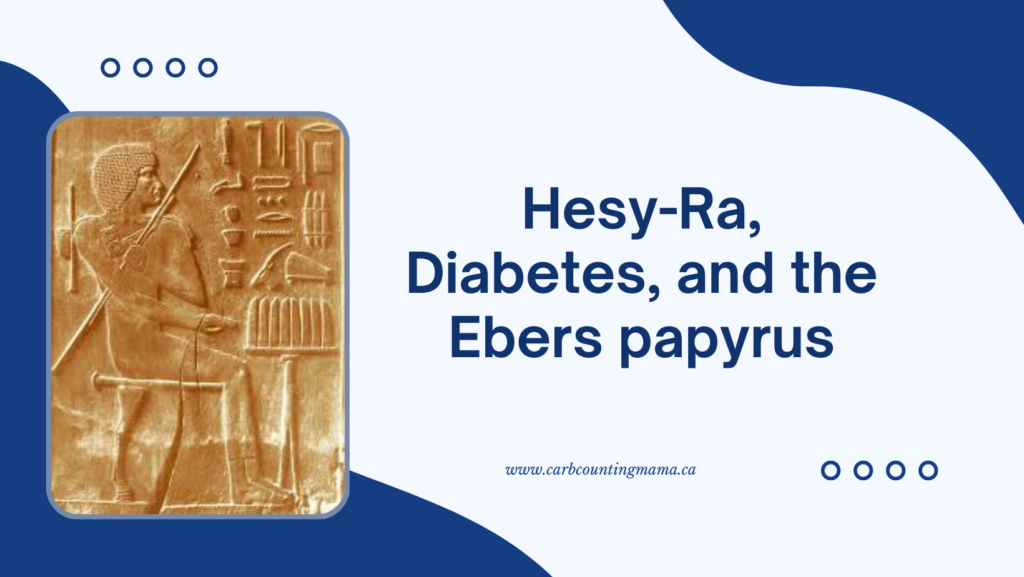It’s been over 100 years since the discovery of insulin. It’s interesting to look back and see how far we’ve come. Our understanding of T1D has evolved a lot over the last few decades. But diabetes goes back quite a bit farther than that. Civilization’s journey with T1D actually started a few millennia ago with Hesy-Ra in Ancient Egypt.

Who was Hesy-Ra?
Hesy-Ra lived during the Third Dynasty of Ancient Egypt (around 2600 BC). He was known as the first dentist to treat tooth decay in the pharaohs. Dentists and physicians were somewhat interchangeable back then.
He had titles that roughly translate to “great one of the ivory cutters”, “great one of the dentists”, and “chief of dentists and physicians”.
He is also the first person, that we know of, who wrote about patients having urine that was “too plentiful”, and he attempted to treat it.
Of course, Hesy-Ra didn’t know what was causing excessive urine in his patients. So all he was treating was the symptom itself.
How we know about Hesy-Ra
The Ebers Papyrus was created around 1550 BC.
It is one of the most famous documents about how Ancient Egyptians practiced medicine. In it, there are around 700 spells, magical formulas, and folk remedies.
It is widely believed that the information in it was copied from older books. Much older books. One part dates back to the First Dynasty (around 3400 BC).
Ancient Egyptians had ways to tell if a woman was pregnant (early gynecology) and thoughts on mental disorders like depression. They were figuring out how the organs work, particularly the heart and kidneys. It is all in the Ebers Papyrus.
German Egyptologist, George Ebers, had the papyrus published in 1875. It was later translated into English and other languages.
The section about diabetes, among other things, has been credited to Hesy-Ra, who lived over a thousand years before the Ebers Papyrus was created. So while the first mention of diabetes is often said to be in 1552 BC, that’s only the date of the Ebers Papyrus. Hesy-Ra would have written about diabetes somewhere else over a thousand years prior to that.
Elderberry anyone?
In the passages about diabetes, the common ancient treatment is explained in detail.
The remedy “to eliminate urine which is too plentiful” was: “A measuring glass filled with Water from the Bird pond, Elderberry, Fibers of the asit plant, Fresh Milk, Beer-Swill, Flower of the Cucumber, and Green Dates.”
No one is sure what plant the “asit” was, but it doesn’t really matter. The treatment wasn’t successful.
However, if you’ve ever been told about “cures” for your T1D, you might have heard about elderberry or cucumber flowers before. Not quite as popular as the cinnamon or okra water cures… but at least these ones have some historical context.
Don’t worry, Hesy-Ra had an alternate treatment…
Maybe bird pond water isn’t for you. Don’t worry! The Ebers Papyrus lists another treatment for urinary troubles:
A rectal injection of olive oil, honey, sweet beer, sea salt, and seeds of the wonderfruit.
Ok, maybe that’s not something that anyone would want to do either. I guess it’s kind of comforting to know that for as long as we’ve been aware of diabetes, we’ve had bizarre ideas about how to treat it.
The significance of Hesy-Ra and the Ebers Papyrus
Hesy-Ra didn’t get very far with his discovery. But the discovery itself was very important.
Nowadays, information gets around quickly and we learn at a much faster rate than people did back in Ancient Egypt.
The next significant thing to happen in the world of diabetes was in Ancient Greece, when the word “diabetes” was first coined.
Egyptian medicine largely influenced the medical practices of other cultures, including Ancient Greece. If we didn’t have people like Hesy-Ra, who took the time to study the human body and write down their findings, we might not be where we are today.
We live in a world where we can survive with T1D by using insulin. We can do a simple finger poke to know what our blood glucose level is at any given time. Or, we could even use a CGM or FGM system and have continuous access to our glucose numbers without the finger pokes.
Diabetes has been around for thousands of years. But we’ve only recently figured out effective ways to manage it. We’re very lucky to live during a time that there is a treatment that works and we have various management methods to choose from.
Did you know that diabetes dates back to Ancient Egypt? Have you ever thought about what it would be like to have diabetes during that time?
For more tips and stories about T1D, join the Carb Counting Mama email list, and make sure to head over to the Carb Counting Mama Facebook page and “like” it.
Leave a Reply